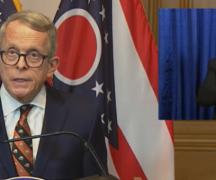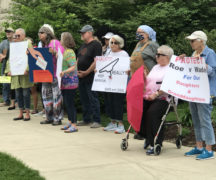Ohio Capital Journal
With his eyes on gradually reopening Ohio’s economy, Gov. Mike DeWine said Friday that the state is positioned to effectively double its COVID-19 testing capacity in a matter of days.
State data shows between April 1 and Friday, an average of about 3,300 Ohioans per day were tested for COVID-19, the respiratory disease caused by the new coronavirus.
State health officials say shortages of testing supplies have shrouded views of the full scope of the outbreak.
In his daily press briefing, however, DeWine claimed that by Wednesday, Ohio will have the capacity to administer 7,200 tests per day. By May 6: 15,000 per day. May 13: 18,800. May 27: 22,000.
In making the claim, DeWine is throwing down the gauntlet on an issue that has marred Ohio and the country at large since officials first detected the virus in Washington state in late January: insufficient testing.
Testing is currently prioritized for the elderly, the immunocompromised, health care workers,and those with certain preexisting conditions. Shortages of swabs and reagents have held back production.
DeWine said the broader testing will enable the state to surveil nursing homes, homeless shelters, and other congregate settings — notorious sites of viral spread. It will also enable a generally more “aggressive” response to infections.
“This capacity will give us a much better opportunity to deal with hotspots wherever they occur,” he said. “When we have a breakout, we will be able to move in and do the testing we need to do.”
DeWine attributed the increased capacity to a state agreement with Thermo Fisher Scientific, a massive health-tech company, to produce testing reagents and Roe Dental Lab in Cleveland to manufacture and mass-produce swabs.
In interviews and statements, public health officials around the state have bemoaned the lack of testing capabilities as the May 1 reopening date looms.
While DeWine has not released details about which businesses can reopen (he said he will on Monday), epidemiologists agree there simply must be more testing.
In a news conference Friday morning (before DeWine spoke), Cuyahoga County Board of Health Commissioner Terry Allan said the 102,000 Ohioans — about 1% of the population — who had been tested at the time are not nearly enough for a clear view of the outbreak.
“We know that we need to do better, and testing needs to be made more widely available. It continues to be a challenge,” he said.
The successful deployment of a COVID-19 vaccine or treatments could be years away.
Until then, Allan says outbreaks, clusters and other “reignitions” could be the norm. The challenge will be rapid identification and containment.
“What we expect, and the models talk about is, in the coming months we may face a range of clusters that may still emerge,” he said. “We have to be prepared to identify, respond to, and suppress clusters of illness going forward. That may very well be the order of the day.”
After the governor spoke, Angy El-Khatib, vice president of the Ohio Society for Public Health Education, said expanded testing is the “number one capability we need right now” to ease social distancing mandates.
It’s not just testing, however. She said Ohio needs to scale up contact tracing and availability of personal protective equipment.
“If we don’t have effective surveillance, containment and case management, we’re not going to be able to ensure public safety,” she said.
Even then, she’s not sold that the data really shows it’s safe to reopen. Hospitalizations are flat, but new cases keep coming every day by the hundreds, and an average of 35 deaths have been reported per day over the last week, despite extraordinary quarantine orders and social distancing measures.
“None of the data is showing me that to make me feel any better about it,” she said.
The numbers
As of Sunday, nearly 16,000 Ohioans have confirmed cases of COVID-19, 728 of whom have died, per state data. Nearly 3,200 people have been hospitalized from the disease.
Nationwide, more than 956,000 Americans have been infected, about 54,000 of whom have died, per data from Johns Hopkins University.
Ohio’s epidemics have proved especially pernicious in prisons and nursing homes. More than 3,800 of Ohio’s 49,000 inmates have confirmed cases, at least 18 of whom have died, as of Saturday. The disease was first detected in the penal system March 29.
One corrections officer has died, and another 376 prison workers have confirmed cases as well.
State data released Wednesday shows 1,199 cases trace back to nursing home residents. Another 477 staff at the facilities have confirmed cases as well.
***
Vinton County officials confirm COVID-19 cases; all 88 counties in Ohio affected
The Vinton County Health Department has confirmed two local cases of the coronavirus, ending the county’s 11-day run as the only one in Ohio without a confirmed case.
The health department confirmed the cases on Saturday evening. A local nurse had confirmed to the Ohio Capital Journal she had tested positive earlier in the evening.
Both individuals were tested elsewhere, as Vinton County does not have a hospital or other available testing means. County-by-county data has typically involved reporting the cases of residents in each county, not necessarily where they were tested. READ MORE





